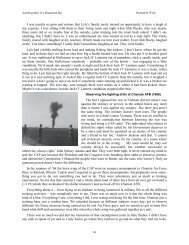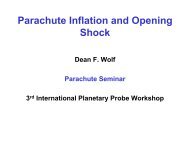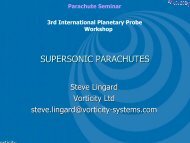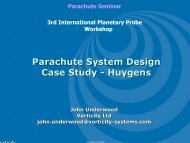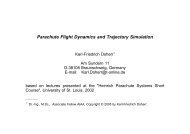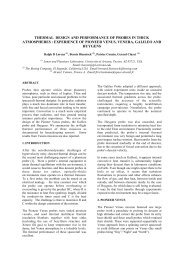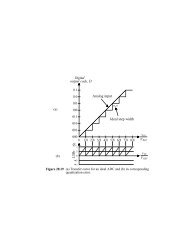Huygens' entry and descent through Titan's atmosphere ...
Huygens' entry and descent through Titan's atmosphere ...
Huygens' entry and descent through Titan's atmosphere ...
Create successful ePaper yourself
Turn your PDF publications into a flip-book with our unique Google optimized e-Paper software.
1864<br />
covariance matrix shown on the top of the figure. The right<br />
side represents the reconstruction of the <strong>descent</strong> phase<br />
trajectory, which is based on atmospheric in situ measurements<br />
as outlined in the previous sections. Both trajectories<br />
overlap in the time interval from about 6.3 to 22 min past<br />
interface epoch. This corresponds to an altitude range of<br />
about 145–100 km. In this ‘‘overlap region’’ residuals . in<br />
altitude <strong>and</strong> <strong>descent</strong> speed are calculated <strong>and</strong> used as input<br />
in a weighted least-squares estimation algorithm. The task<br />
of the statistical estimation algorithm is to calculate initial<br />
state vector corrections, which ensures a smooth transition<br />
between the <strong>entry</strong> <strong>and</strong> <strong>descent</strong> phase trajectory portions in<br />
terms of both altitude <strong>and</strong> <strong>descent</strong> speed.<br />
Note that the residuals in the horizontal components<br />
(i.e., meridional <strong>and</strong> zonal probe drift) are not considered<br />
in the estimation algorithm. When the DTWG trajectory<br />
retrieval algorithm design was designed, reliable measurements<br />
of meridional motion were not expected. The<br />
inclusion of horizontal residuals into the estimation<br />
algorithm is subject to future analysis.<br />
As only corrections within the specified uncertainty<br />
range should be considered it is necessary to provide the<br />
least-squares algorithm with the capability to take into<br />
account the a priori covariance matrix P apr<br />
0<br />
of the initial<br />
(modeled) state vector ~x apr<br />
0 . Introducing the information<br />
matrix K as the inverse of the covariance matrix, the<br />
following solution x lsq<br />
0 of the weighted least-squares<br />
estimation (with a priori knowledge) is used (e.g.,<br />
Montenbruck <strong>and</strong> Gill, 2000)<br />
Dx lsq<br />
0 ¼ðKþ HTWHÞ 1 ðKDx apr<br />
0 þ HTW.Þ, (23)<br />
where H is the Jacobian containing the partial derivatives<br />
of h with respect to the initial state vector x0 at the initial<br />
(i.e., interface) epoch t0, <strong>and</strong> h is the vector<br />
h ¼ zðx0Þ<br />
( )<br />
(24)<br />
_zðx0Þ<br />
which consists of the altitude <strong>and</strong> <strong>descent</strong> speed derived<br />
from the integrated probe initial state vector. The weighting<br />
matrix W is a diagonal matrix <strong>and</strong> contains the variances<br />
of the residuals, which are derived from the uncertainties of<br />
z <strong>and</strong> _z as shown in Fig. 14. Furthermore it is worth noting<br />
that the assumption of independent measurements z <strong>and</strong> _z<br />
(i.e., diagonal matrix W) provides the best convergence of<br />
the estimation algorithm, even if both observables result<br />
from an integration of initial conditions <strong>and</strong> are therefore<br />
not fully independent quantities.<br />
Table 2 lists the probe state vector <strong>and</strong> uncertainties as<br />
provided by the Cassini Navigation team as well as the<br />
adjusted state vector, which result from the converging of<br />
the trajectory merging algorithm. The last column of this<br />
table shows the deviation of the corrected state vector<br />
expressed in units of the state vector uncertainties from the<br />
second column.<br />
The overlapping portion of the <strong>entry</strong> <strong>and</strong> <strong>descent</strong> phase<br />
altitude <strong>and</strong> <strong>descent</strong> speed profiles are shown in Fig. 19. It<br />
ARTICLE IN PRESS<br />
B. Kazeminejad et al. / Planetary <strong>and</strong> Space Science 55 (2007) 1845–1876<br />
Altitude [km] above Impact Point<br />
Altitude Residual: Entry - Descent [m]<br />
180<br />
170<br />
160<br />
150<br />
140<br />
130<br />
120<br />
110<br />
100<br />
90<br />
80<br />
5 10 15 20 25 30<br />
Time [min]<br />
past Interface Epoch: UTC: 2005-01-14T09:05:52.523<br />
200<br />
100<br />
0<br />
-100<br />
-200<br />
-300<br />
-400<br />
-500<br />
can be seen that the modifications of the initial state vector<br />
ensures a smooth transition between the two phases. The<br />
difference between the two reconstructed altitude profiles<br />
are less than 0.6 km (in the overlapping region of ca.<br />
147–100 km), which is shown in the residual plot in the<br />
lower panel of the same figure.<br />
7. Vehicle roll rate<br />
T0 Drogue<br />
7.1. Vehicle roll during <strong>entry</strong><br />
ENTRY<br />
DESCENT<br />
-600<br />
6 8 10 12 14<br />
Time [min]<br />
16 18 20 22<br />
past Interface Epoch: UTC: 2005-01-14T09:05:52.523<br />
Fig. 19. Comparison of reconstructed altitude profiles from the <strong>entry</strong><br />
phase reconstruction (dashed thick line) <strong>and</strong> the <strong>descent</strong> phase reconstruction<br />
(solid line). The lower panel shows the corresponding altitude<br />
residuals in the overlapping altitude region.<br />
The Huygens probe postseparation axial <strong>and</strong> lateral<br />
velocity as well as the roll rate 5 were reconstructed from the<br />
Cassini bounce back reaction <strong>and</strong> the measurements of the<br />
5<br />
Note that in various Huygens papers the probe roll rate is also referred<br />
to as probe ‘‘spin’’.



